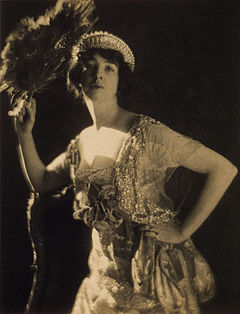
Portrait of Queen Charlotte by Thomas Gainsborough 1781
Fans started from the depths of crude necessity, but they were destined to reach the heights of refined luxury. The reason for this is that the fan has proved itself one of the greatest aids to the cause of femininity. It reached its greates height of use and adornment in the eighteenth century. "The pretty woman used it, knowing she added to her charms; the clumsy woman used it in order to occupy her hands; the ugly woman used it, as thereby she might at least obtain credit for elegance." Queen Charlotte, the wife George III, is a distinguished example of the type last mentioned. A famous artist, on seeing Reynolds' portrait of her, fan in hand, exclaimed: "Lord, how she held that fan!"

Gertrude Vanderbilt Whitney by Adolph de Meyer
There are many stories as to the actual origin of the fan and it's brilliant success in Europe in the seventeenth and eighteenth centuries. The most romantic story is that the first fan was a wing torn from Zephyr by Cupid, to protect the sleeping Psyche. A far less romantic explanation of the fan's rise in popularity is the story of the revenge in taste upon a rude queen by the ladies of a certain European court. This surprising use of the the fan soon spread, and in a few years eminent writers in France and England were lauding its praises.
Madame D'Arblay described the fan as the most useful ornament "belonging to full dress: occupying the hands, giving the eyes something to look at, and taking away stiffness and formality from the figure and deportment." The Baronne de Chapt, in "Oeuvre Philosophique," Vol.I, exhorts all fashionable women in Society to learn how to make the best use of the fan. Balzac's famous comment on the fan of Madame Pompadour is too well known to be repeated. Addison wrote: "Women are armed with fans as men are armed with swords."
But it was left for Victorian England, in the person of the distinguished poet Austin Dobson, to perform the most excellent service to the fan:
"Chicken skin delicate, white,
Painted by Carl Vanloo, Loves in a riot of light, Roses and vapours blue. Hark to the dainty frou frou, Picture above, if you can, Eyes that could melt as the dew- This was the Pompadour's Fan!"The allusion to chicken skin in the first line of this little poem is made because many exquisite fans were made from this material. It will now be interesting, in conclusion, to refer to some of the types of famous fans.
Brise fans contain no leaf. They are made of some stiffish substance such as ivory, bone, tortoiseshell, horn, filigree, silver or wood. The materials are used in extraordinarliy thinslices and in many cases have been perforated and sewn into lace-like openwork.
Cabriolet fans are characterized mainly by the subject of the decoration, usually one that deals with motion, such as one-horse chariots (cabriolet), sledging, skating. In most cabriolet fans the leaf is divided into two parts with independant ornamentation.

Peacock fan and gloves
Other type of fans are puzzle or mystery fans and lorgnette or quizzing fans. With the puzzle or mystery fans different pictures could be shown, in accordance with the way the fan was manipulated. The lorgnette fan had a vogue when affectation was "the correct thing." The lorgnette was ingeniously made, so that when held close to the eye, apparently shading the owner from witnessing, say a risque scene in a play, it gave visibility to the scene by means of peepholes.
There was a special kind of fan decorated with scriptural subjects called the Church Fan. It had many uses; thus aids to memory, in addition to entertaining pictures, were painted on them. Vellum or (or decoupe) fans, now very rare indeed, were very fashionable during the sixteenth and seventeenth centuries. Silk is, of cours, a material of which some of the finest fans have been made. Many kinds of silk fans carried spangles. One of the daintiest kinds of fan is the "Empire" fan, which came into fashion after the French Revolution. It is small, rarely exceeding seven inches in length, and was made of silk, net, gauze, satin or lace.